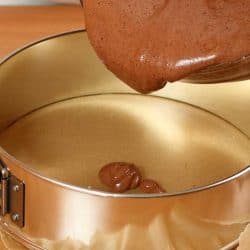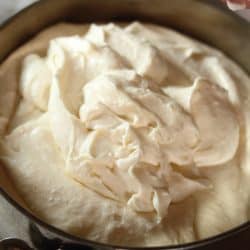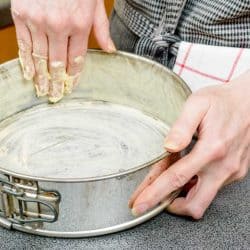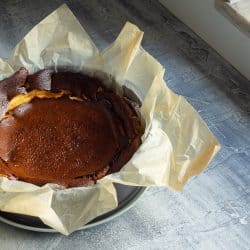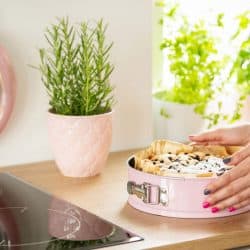A springform pan is designed to ease, not hinder, the baking process. Specifically, it enables you to release delicately layered cheesecakes, quiche, and trifles for a flawless presentation without toppling over! Whether you've used a springform pan or are trying this technique for the first time, you might wonder if springform pans are supposed to leak. We've researched how to use a springform pan properly to get the answer for you.
Because springform pans comprise two separate pieces (a flat base and detachable, form-fitting rim), they are notoriously known for leaking. There is no seal between the base and rim, meaning the batter can leak out, and water from a bain-marie can leak in. So, to prevent or minimize leaks, most bakers line the inside of a springform pan with parchment paper to help seal the attachment. Additionally, wrapping the base's exterior with aluminum foil or saran wrap will deter leaking out or seeping into the pan.
If a springform pan is the best bakeware for your next dessert, you'll want to ensure it is lined properly to prevent excess leaks. After all, only the batter inside the pan will cook! Please keep reading to learn just how to line and wrap your pan. We'll also provide some great alternatives to keep your batter inside the pan and keep your oven clean.
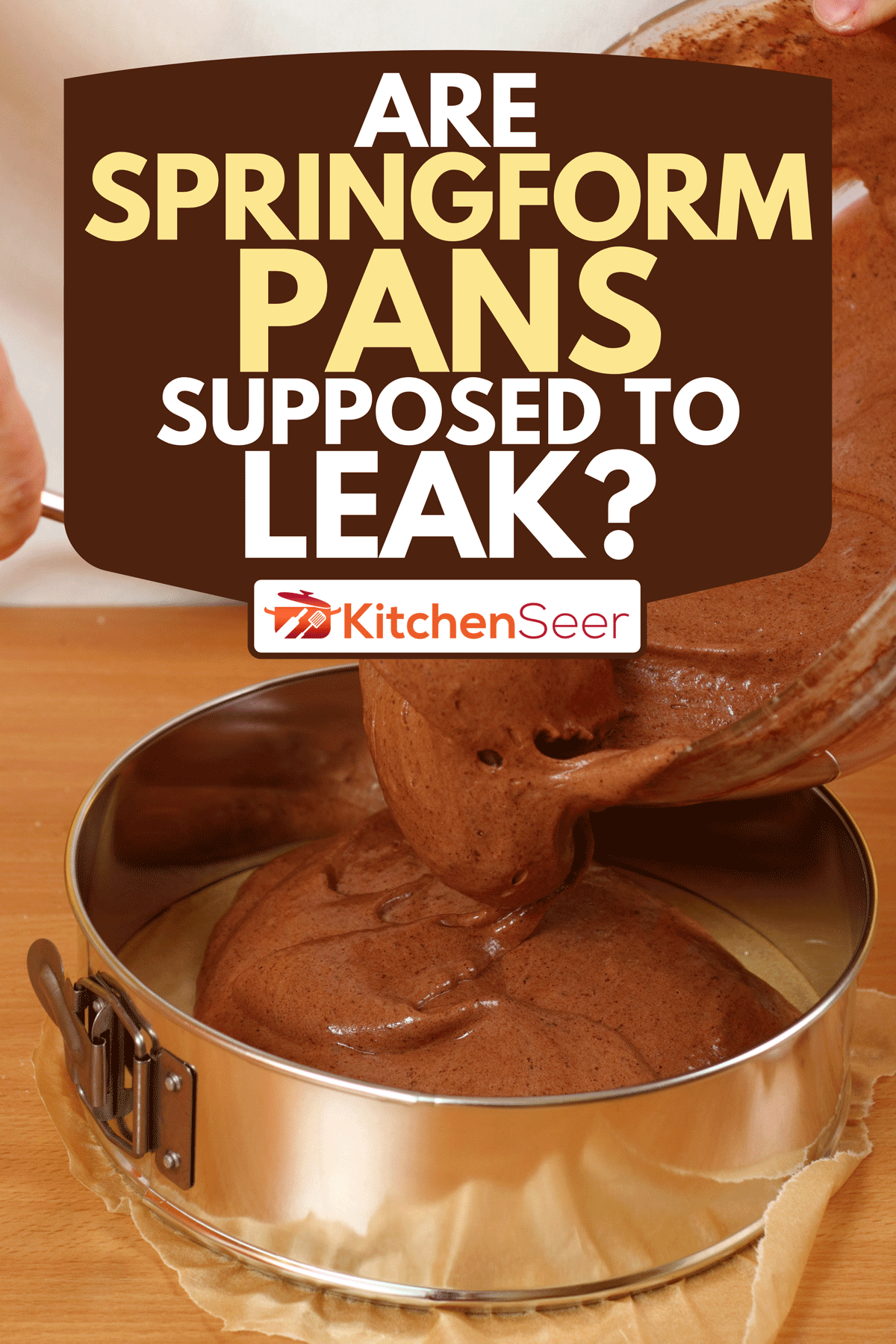
How Do You Stop A Springform Pan From Leaking?
While you may not be able to stop your springform pan from leaking, you can minimize the mess and keep most of your batter intact while baking with a few simple tricks.
Parchment Paper Lining
Using parchment paper to line the pan's base helps you easily release your delicious recipe and creates a seal between the springform pan's base and rim. First, gather a few essentials: scissors, parchment paper, and spreadable grease (optional). Disassemble the pan by unclipping and removing the rim from the base. Now, let's get started!
- Grease the bottom of the pan. This is an optional step, which helps secure the parchment paper by gently sticking to the grease. You can use butter, cooking spray, Crisco, or your preferred spreadable grease. Omitting this step is perfectly OK; it just means you'll have to hold fast to that paper to keep it from sliding when it comes time to secure the pan's rim.
- Cut a piece of parchment paper larger than the pan's base; you'll want it to overlap the edges.
- Lie the parchment paper atop the base and gently press to smooth and affix to the grease (if applied). Leave the overhanging edges of the paper.
- Assemble the rim to the base. Use scissors to trim the overhanging parchment paper edges protruding from beneath the rim.
Aluminum Foil Wrap
Depending on the thickness of your batter, the parchment paper lining should keep most leaks at bay. If you are using a particularly thin batter, you can wrap the pan's base in aluminum foil (or saran wrap) to at least catch leaks and prevent a mess in the oven. Aluminum foil will also add an extra layer of protection to keep water from seeping inside if you are using a bain-marie cooking technique. Take a look at the YouTube video below for a quick visual on how to combine parchment paper lining with aluminum foil wrap to prepare your pan.
Springform Pan Cover
Some springform pans come with a cover sized to fit the base of the pan as a catchment. If your springform pan does not have this feature, you can opt to buy a cover separately. Or you can simply set the springform pan into another, larger pan while baking.
Click here to see this leakproof, springform pan with silicone handles on Amazon.
Double-Up Pans
A cake pan or deep-dish pizza pan with a larger diameter than your springform pan would work nicely for the method described above, similar to using a springform pan cover. Simply line the springform pan using parchment paper on the base, as you would otherwise, then set it into the larger pan prior to adding batter and baking. If you are mixing and matching bakeware, ensure that all of the pans are oven-safe.
Click here to see this 14" deep-dish pizza pan on Amazon.
Leakproof Springform Pans
While the name implies no leaks, even springform pans advertised as leakproof will still occasionally leak. Nordic Ware makes just one example of a reputable, non-leaking springform pan. Although somewhat less mess due to a tighter seal with a low lip, do not be surprised if you've fronted the extra dough for a leakproof pan design that does not live up to its name.
Click here to see Nordic Ware 10" leakproof springform pan on Amazon.
Can You Line The Bottom of a Springform Pan With Parchment Paper?
Parchment paper is an excellent choice for lining a springform pan because it is both heat-resistant and non-stick. You might also hear parchment paper referred to as baking paper. It is a baker's staple, commonly used for lining bakeware, covering a countertop to roll-out dough atop for easy clean-up afterward, covering a countertop to measure over, allowing easy scooping and funneling of loose ingredients, and wrapping baked goods for storage.
Check out our post, "Do You Need To Line A Springform Cake Tin?" for some great tips and tricks on how to use parchment paper to prepare your pan.
Should I line a cheesecake pan?
Typically, you'll use a springform pan for making cheesecake. Consult your recipe to determine whether it recommends greasing or lining the pan. Follow the recipe's recommendation. If you line the pan in addition to greasing it, the parchment paper will reduce the occurrence of leaks. Check out this yummy Best Cheesecake Recipe for your next dessert!
Will Cake Batter Leak in a Springform Pan?
Springform pans work best for thicker batters. However, leaks are inevitable. It's best to use a cake pan for baking cake batter because it will not leak. If you are worried about releasing your cake from the pan, you can grease or line the pan just as you would have done with a springform pan.
Click here to see this 8" aluminum cake pan set on Amazon.
You might also be interested in using a flexible silicone cake pan for an easy release of the cooked cake. A silicone pan will not leak and does not require lining with parchment paper, although it may be a bit tricky to get it into the oven without a spill! You can set it on top of a cookie sheet or inside of a larger pan for an easy transfer for the wobbly batter. Silicone pans are also great for freezing your desserts and popping the dessert out of the pan to thaw.
Click here to see this 8" silicone cake pan set on Amazon.
Final Thoughts
Springform pans are incredibly useful for a non-stick release of delicate desserts. However, leaking is inevitable, so you'll want to use some of the tips we've discussed to prepare your pan. If you don't have parchment paper handy, you might consider "5 Easy Baking Paper Sheets Alternatives."






